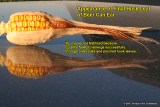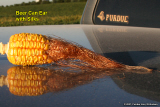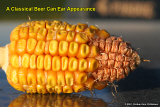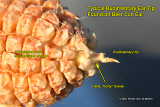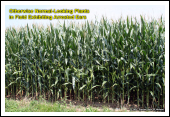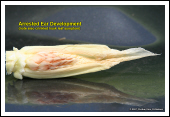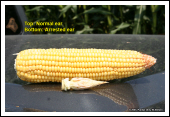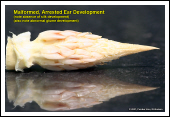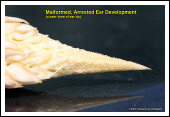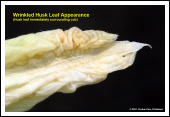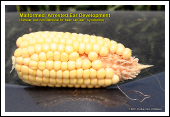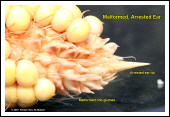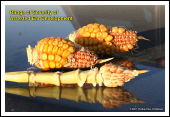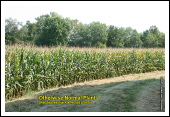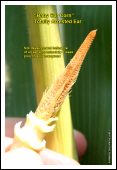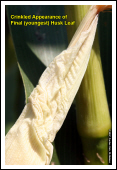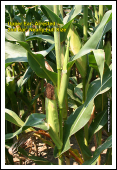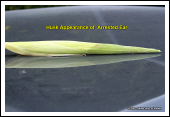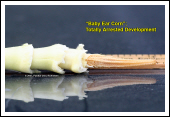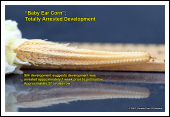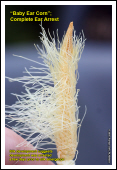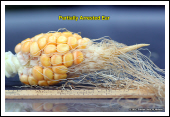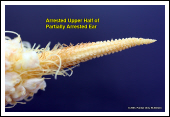




Published 4 Sep 2007
URL: http://www.kingcorn.org/news/articles.07/ArrestedEars-0904.html
Symptomology of Arrested Ear Development in Corn
R.L. (Bob) Nielsen
Agronomy Dept., Purdue Univ.
West Lafayette, IN 47907-2054
Email address:
![]() eports
of arrested ear development in cornfields continue to surface around the
Midwest this year. Circumstantial evidence in some situations links the
symptoms to post-emergence applications of herbicides, fungicides, insecticides,
and/or assorted additives. In other situations, no obvious connection
can be identified with post-emergence pesticide applications. Definitive
diagnoses of the causes of arrested ear development remain to be determined,
but it may be useful to compare and contrast the various arrested ear
symptoms and what they may tell us in terms of the timing of the damage.
Too often, folks identify a cause of a problem before clearly identifying
the symptoms.
eports
of arrested ear development in cornfields continue to surface around the
Midwest this year. Circumstantial evidence in some situations links the
symptoms to post-emergence applications of herbicides, fungicides, insecticides,
and/or assorted additives. In other situations, no obvious connection
can be identified with post-emergence pesticide applications. Definitive
diagnoses of the causes of arrested ear development remain to be determined,
but it may be useful to compare and contrast the various arrested ear
symptoms and what they may tell us in terms of the timing of the damage.
Too often, folks identify a cause of a problem before clearly identifying
the symptoms.
Whole Plant Symptoms
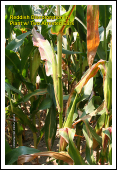 In almost every reported situation of arrested ear development, the overall
appearance of the remainder of an affected plant is normal for the given
hybrid; e.g., plant height, plant color; leaf size and number; and tassel
size and appearance. The exception is that the leaf midribs, leaf blades,
and leaf sheaths of plants with severely arrested ears and near total absence
of kernels eventually redden (anthocyanin pigments) late in the grain filling
period in response to the higher than normal concentration of plant sugars
in the leaves (plenty of photosynthetic output, no grain to accept it).
In almost every reported situation of arrested ear development, the overall
appearance of the remainder of an affected plant is normal for the given
hybrid; e.g., plant height, plant color; leaf size and number; and tassel
size and appearance. The exception is that the leaf midribs, leaf blades,
and leaf sheaths of plants with severely arrested ears and near total absence
of kernels eventually redden (anthocyanin pigments) late in the grain filling
period in response to the higher than normal concentration of plant sugars
in the leaves (plenty of photosynthetic output, no grain to accept it).
The fact that the remainder of an affected plant appears otherwise normal suggests that the cause of the arrested ear is NOT a lingering or cumulative type of stress (e.g., compaction, drought stress, nutrient deficiency), but rather a single stress event that directly affected the developing ear.
Click on image to open a larger version. To close popup window, click on larger image.
Husked Ear Symptoms
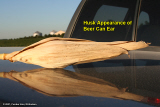 At
some point during the grain filling period, the outward appearance of
affected ear shoots is visibly different than normal ear shoots simply
because the smaller than normal cob/ear alters the shape of the husked
ear. Sometimes the diameter of the husked ear is fairly normal at the
butt of the arrested cob, and then pinches near the tip. In other situations,
the diameter of the husked ear is noticeably smaller throughout. In the
case of severely arrested ears, silks may never emerge from the ends of
the husk leaves due to silkballing inside the husk leaves.
At
some point during the grain filling period, the outward appearance of
affected ear shoots is visibly different than normal ear shoots simply
because the smaller than normal cob/ear alters the shape of the husked
ear. Sometimes the diameter of the husked ear is fairly normal at the
butt of the arrested cob, and then pinches near the tip. In other situations,
the diameter of the husked ear is noticeably smaller throughout. In the
case of severely arrested ears, silks may never emerge from the ends of
the husk leaves due to silkballing inside the husk leaves.
 The
number and length of husk leaves on affected ears are usually normal,
though sometimes the husks are noticeably shorter with damaged tips. Occasionally
the final one or two husk leaves (youngest, immediately adjacent to cob)
are somewhat short and exhibit an unusual crinkled texture (aka accordion
bellows for you older readers). This latter symptom seems most common
in fields where post-emergence injury due to herbicides, fungicides, insecticides,
or additives is thought to be involved with the arrested ear development.
Indeed, the fact that the remainder of the husk leaves on such severely
arrested ears is relatively normal suggests that the cause of the problem
in these fields occurred late in the development of the ear shoot, but
prior to pollination.
The
number and length of husk leaves on affected ears are usually normal,
though sometimes the husks are noticeably shorter with damaged tips. Occasionally
the final one or two husk leaves (youngest, immediately adjacent to cob)
are somewhat short and exhibit an unusual crinkled texture (aka accordion
bellows for you older readers). This latter symptom seems most common
in fields where post-emergence injury due to herbicides, fungicides, insecticides,
or additives is thought to be involved with the arrested ear development.
Indeed, the fact that the remainder of the husk leaves on such severely
arrested ears is relatively normal suggests that the cause of the problem
in these fields occurred late in the development of the ear shoot, but
prior to pollination.
Ear Symptoms
The appearance of affected ears represents the most dramatic symptom, but the nature of the symptom varies one field to another. Because the ear symptoms vary so dramatically, the causes of the arrested ears may also vary.
Beer Can Ears. The ear symptom I am most familiar with is that associated with the classical “beer can ear” (BCE) or “blunt ear” syndrome (BES). The BES form of arrested ear development was first reported in Colorado back in the late 1980’s and throughout corn growing areas of the U.S. ever since. I’ve written several articles on this phenomenon over the years when it has occurred in Indiana (Nielsen, 2003; Nielsen, 2004).
The symptoms include a basal end of the cob that contains a fairly normal number of kernel rows (for the specific hybrid) with typically good kernel set, but then truncates completely partway up the cob and ends with a rudimentary tip of the ear shoot that has no evidence of silk formation whatsoever. The distal end of the cob is often barren because silks from that area failed to emerge through the pinched husk leaves.
Click on image to open a larger version. To close popup window, click on larger image.
The exceptionally few number of kernels/ovules per row plus the appearance of the rudimentary tip of the ear shoot suggest that the cause of the problem occurred prior to the completion of ear size determination and ear shoot differentiation; no later than leaf stages V12 to V15. The greater the severity of arrested ear (i.e., “hand grenade” symptoms or worse), the earlier the problem occurred during ear size determination; while the lesser the severity (i.e., “tall beer can” symptoms), the later the problem occurred during ear size determination.
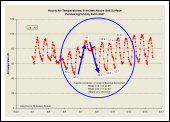 I’ve
always leaned toward the theory of cold temperature shock or that due
to wide swings in temperature during ear size determination as possible
contributing factors for the development of beer can ears (Nielsen, 2003;
Nielsen, 2004). Indeed, the 2007 growing season included a cold/hot/cold
pattern in the early days of June when many late April or early May plantings
would have been in the early stages (V6 - V8) of ear size determination.
I’ve
always leaned toward the theory of cold temperature shock or that due
to wide swings in temperature during ear size determination as possible
contributing factors for the development of beer can ears (Nielsen, 2003;
Nielsen, 2004). Indeed, the 2007 growing season included a cold/hot/cold
pattern in the early days of June when many late April or early May plantings
would have been in the early stages (V6 - V8) of ear size determination.
Malformed & Arrested Ears. Another form of arrested ear development reported in cornfields this summer is characterized not only by arrested development, but also by malformed cob tissue. The ovule glumes on the basal portion of the cob are unusually long; the mid-section of the cob often has a hard “bony” texture, while the tip of the cob simply seems to have ceased differentiation. These malformed, arrested ears often show very little evidence of silk formation whatsoever.
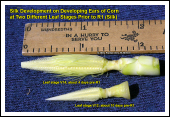 Silk
presence or absence can be used to guesstimate the timing of the ear arrest
by virtue of the fact that silk elongation begins near the butt of the
cob around leaf stage V12 and is usually clearly visible by V14. The nearly
normal number of ovules per row plus the absence or near absence of visible
silks suggests that these ears were arrested near the end of ear size
determination but prior to or very shortly after initiation of silks at
the basal ends of the cobs. Depending on the hybrid, such timing might
correspond to leaf stages as early as V12 or approximately 2 weeks prior
to pollination. For malformed, arrested ears that exhibit more evidence
of silk development, the timing of the stress may have been later but
still prior to pollination.
Silk
presence or absence can be used to guesstimate the timing of the ear arrest
by virtue of the fact that silk elongation begins near the butt of the
cob around leaf stage V12 and is usually clearly visible by V14. The nearly
normal number of ovules per row plus the absence or near absence of visible
silks suggests that these ears were arrested near the end of ear size
determination but prior to or very shortly after initiation of silks at
the basal ends of the cobs. Depending on the hybrid, such timing might
correspond to leaf stages as early as V12 or approximately 2 weeks prior
to pollination. For malformed, arrested ears that exhibit more evidence
of silk development, the timing of the stress may have been later but
still prior to pollination.
Click on image to open a larger version. To close popup window, click on larger image.
“Baby Ear” Arrested Corn. Another form of arrested ear development has the appearance of those baby ears of corn you find at the salad bars of finer eating establishments. This form of arrested ear does NOT exhibit any obvious malformation of cob tissue but does show obvious evidence of initial silk formation. The appearance of the ear is identical to that you would find if you dissected ears from corn plants 7 to 10 days prior to pollination and, thus, suggests that was the timing of the occurrence of the ear arrest. It is as if these young ears were simply “frozen in time” the week prior to tassel.
Click on image to open a larger version. To close popup window, click on larger image.
Summary
So, what is the upshot of all this discussion on the symptomology of arrested ear development in 2007? Basically, I am suggesting that there may be more than one cause of the problems being reported this year based on the range of arrested ear symptoms being reported and the likely timings of their onset. In other words, not every case of arrested ear development can be blamed on herbicide injury; not every case can be blamed on fungicide injury; not every one can be blamed on cold temperature shock.
The “beer can ear” syndrome may be related to temperature shock during ear size determination from roughly leaf stages V6 to V10 (Nielsen’s bias). As I indicated earlier in this article, temperature patterns during the first week of June throughout the northern halves of Illinois, Indiana, and Ohio may have been conducive for such shock.
The “malformed arrested ear” syndrome suggests the occurrence of stress nearer to leaf stage V12 nearer the time when silk elongation begins to occur at the basal portions of the cobs. Such timing would tend to support those who speculate about injury from late post-emergence applications of glyphosate or glufosinate on herbicide-tolerant hybrids, late applications of other post-emergence herbicides; especially plant growth regulators, or “early” pre-tassel applications of fungicide/insecticide/foliar fertilizer/spray additives.
The “baby ear corn” syndrome suggests the occurrence of stress sometime after leaf stage V12 but prior to full silk emergence from the husk leaves. Such timing may agree with affected fields where circumstantial evidence points toward injury from various combinations of fungicide/insecticide/foliar fertilizer/spray additives applied closer to tassel emergence.
Though different in severity and appearance, the symptomology of arrested ear development resembles that caused by plant growth regulators and thus might reflect the consequences of hormone-mediated responses to more than one type of stress. Indeed, Lejeune et al. (1998) suggested that alteration of the ratio of indole acetic acid (IAA) to cytokinin might be involved with the ear abortion they induced with chilling treatments in corn grown under controlled conditions. Grossmann & Retzlaff (1997) documented that the strobilurin fungicide kresoxim-methyl showed auxin-like properties in a series of bioassays and inhibited ethylene formation in treated leaf discs, intact plants, and water-stressed shoots of wheat.
Related References
Grossmann, Klaus and Gunter Retzlaff. 1997. Bioregulatory effects of the fungicidal strobilurin kresoxim-methyl in wheat (Triticum aestivum). Pestic. Sci. 50:11-20.
Lejeune, Pierre, Prinsen, Els, Onckelen, Henry Van, and Bernier, Georges. 1998. Hormonal control of ear abortion in a stress-sensitive maize (Zea mays) inbred. Functional Plant Biol. 25[4]: 481-488.
Nafziger, Emerson. 2007. Unexpected Problems of Corn Ear Development. The Bulletin, Univ. of Illinois IPM. [On-Line]. Available at http://www.ipm.uiuc.edu/bulletin/article.php?id=836 (URL accessed 8/21/07).
Nielsen, RL (Bob). 2003. Blunt Ear Syndrome in Corn. Corny News Network, Purdue Univ. [On-Line]. Available at http://www.kingcorn.org/news/articles.03/BeerCanEars-0812.html (URL accessed 8/21/07, but some of the links contained are “dead” at the moment).
Nielsen, RL (Bob). 2004. Arrested Ear Development (Again!). Corny News Network, Purdue Univ. [On-Line]. Available at http://www.kingcorn.org/news/articles.04/BeerCans-0906.html (URL accessed 8/21/07).
Nielsen, RL (Bob). Rev. 2007. Ear Size Determination in Corn. Corny News Network, Purdue Univ. [On-Line]. Available at http://www.kingcorn.org/news/timeless/EarSize.html (URL accessed 8/21/07).


